Medicalisation of Childbirth in the UK: A Detailed Analysis
VerifiedAdded on 2019/09/18
|9
|3028
|457
Report
AI Summary
This report delves into the medicalisation of childbirth, focusing on the UK context. It explores the integration of biopsychosocial factors in understanding health and illness throughout the life course, particularly during childbirth. The report examines the historical and cross-cultural representations of childbirth, contrasting traditional methods with modern medical interventions. Different theoretical approaches to childbirth, including perspectives from Michel Odent, Margaret Tew, and Anne Oakley, are discussed. The report analyzes various dichotomies, such as midwives vs. obstetricians, home vs. hospital births, and intervention vs. non-intervention, and their impact on childbirth practices. It concludes by highlighting the effects of medicalisation on reducing maternal mortality and changing the perception of childbirth from a normal life event to a medical one, and the shift in care from women to medical professionals.
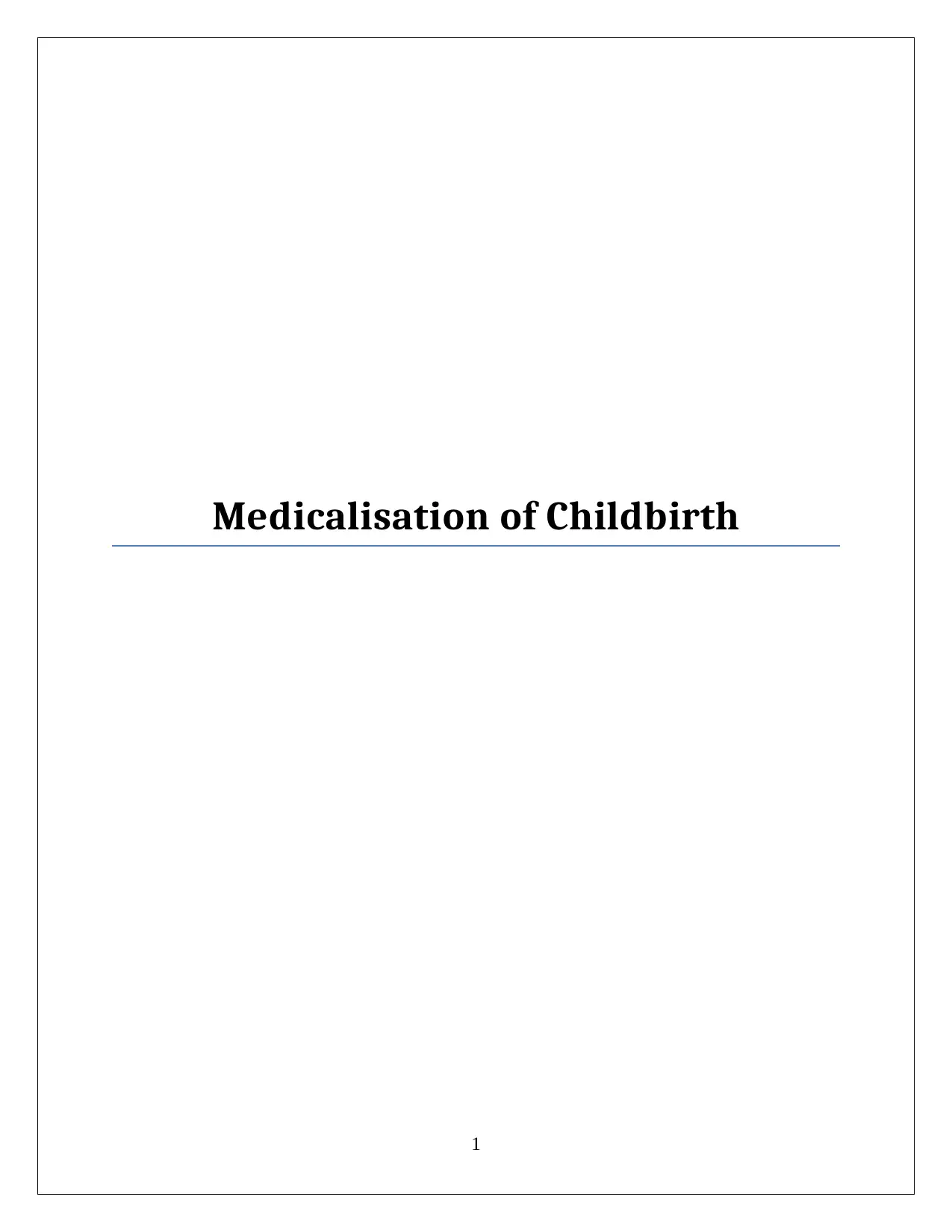
Medicalisation of Childbirth
1
1
Paraphrase This Document
Need a fresh take? Get an instant paraphrase of this document with our AI Paraphraser
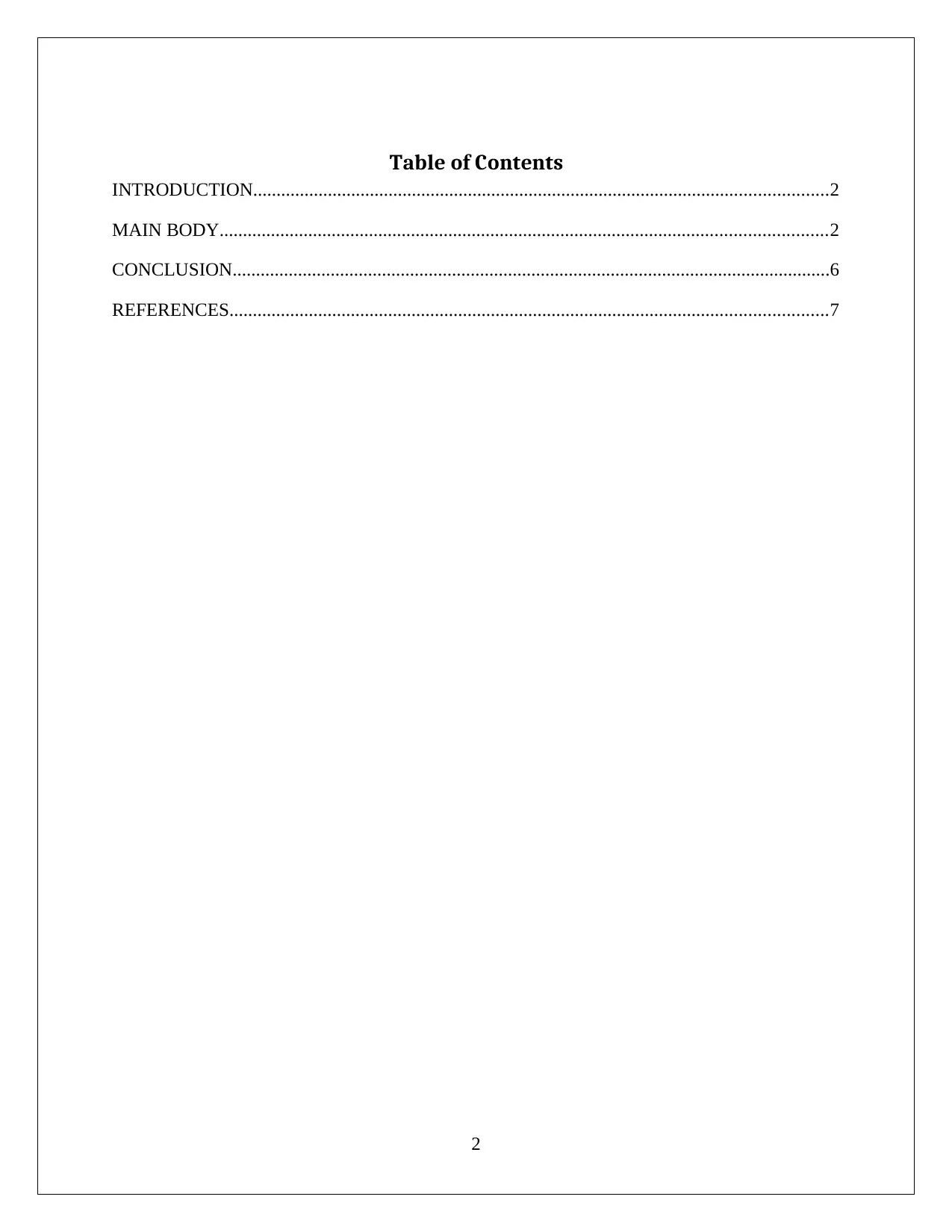
Table of Contents
INTRODUCTION...........................................................................................................................2
MAIN BODY..................................................................................................................................2
CONCLUSION................................................................................................................................6
REFERENCES................................................................................................................................7
2
INTRODUCTION...........................................................................................................................2
MAIN BODY..................................................................................................................................2
CONCLUSION................................................................................................................................6
REFERENCES................................................................................................................................7
2
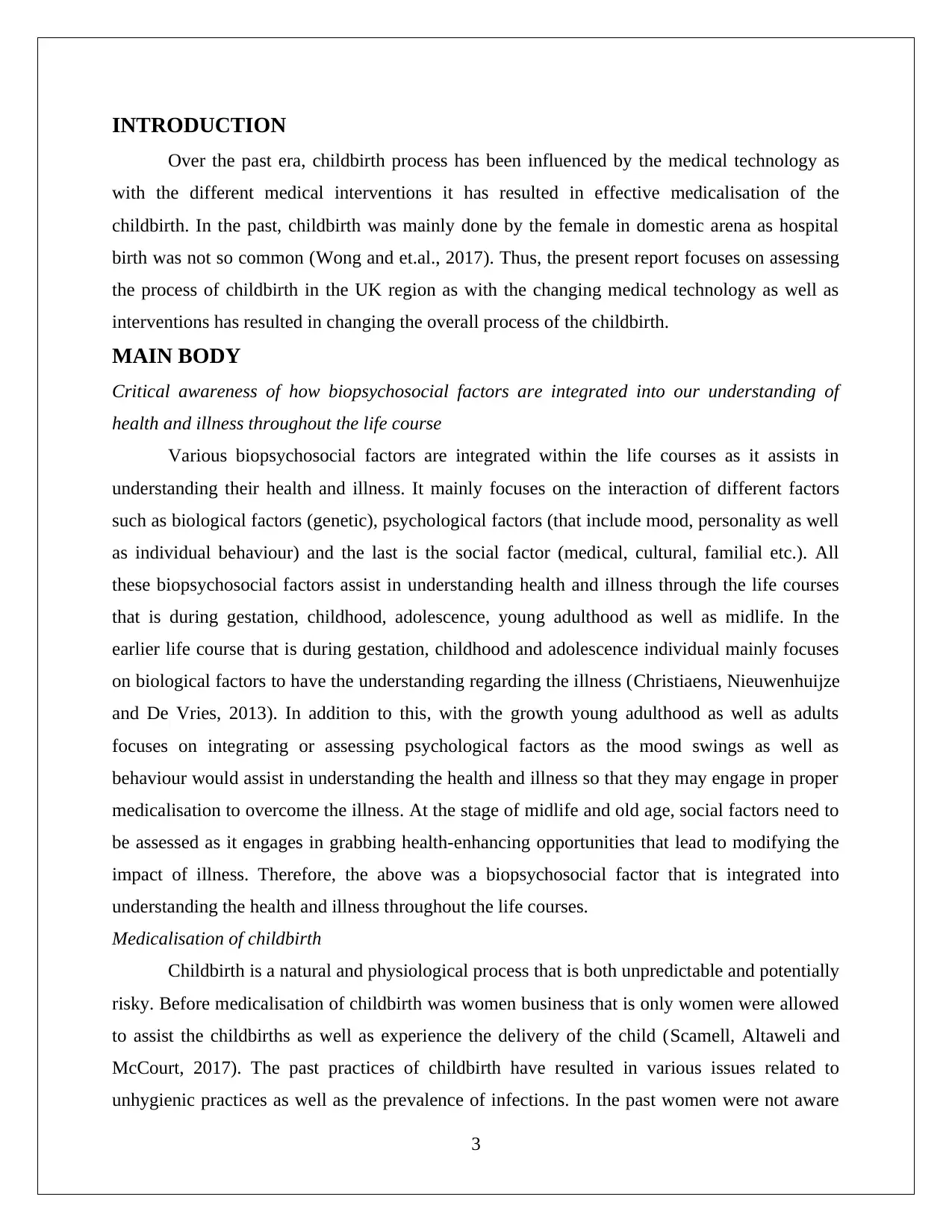
INTRODUCTION
Over the past era, childbirth process has been influenced by the medical technology as
with the different medical interventions it has resulted in effective medicalisation of the
childbirth. In the past, childbirth was mainly done by the female in domestic arena as hospital
birth was not so common (Wong and et.al., 2017). Thus, the present report focuses on assessing
the process of childbirth in the UK region as with the changing medical technology as well as
interventions has resulted in changing the overall process of the childbirth.
MAIN BODY
Critical awareness of how biopsychosocial factors are integrated into our understanding of
health and illness throughout the life course
Various biopsychosocial factors are integrated within the life courses as it assists in
understanding their health and illness. It mainly focuses on the interaction of different factors
such as biological factors (genetic), psychological factors (that include mood, personality as well
as individual behaviour) and the last is the social factor (medical, cultural, familial etc.). All
these biopsychosocial factors assist in understanding health and illness through the life courses
that is during gestation, childhood, adolescence, young adulthood as well as midlife. In the
earlier life course that is during gestation, childhood and adolescence individual mainly focuses
on biological factors to have the understanding regarding the illness (Christiaens, Nieuwenhuijze
and De Vries, 2013). In addition to this, with the growth young adulthood as well as adults
focuses on integrating or assessing psychological factors as the mood swings as well as
behaviour would assist in understanding the health and illness so that they may engage in proper
medicalisation to overcome the illness. At the stage of midlife and old age, social factors need to
be assessed as it engages in grabbing health-enhancing opportunities that lead to modifying the
impact of illness. Therefore, the above was a biopsychosocial factor that is integrated into
understanding the health and illness throughout the life courses.
Medicalisation of childbirth
Childbirth is a natural and physiological process that is both unpredictable and potentially
risky. Before medicalisation of childbirth was women business that is only women were allowed
to assist the childbirths as well as experience the delivery of the child (Scamell, Altaweli and
McCourt, 2017). The past practices of childbirth have resulted in various issues related to
unhygienic practices as well as the prevalence of infections. In the past women were not aware
3
Over the past era, childbirth process has been influenced by the medical technology as
with the different medical interventions it has resulted in effective medicalisation of the
childbirth. In the past, childbirth was mainly done by the female in domestic arena as hospital
birth was not so common (Wong and et.al., 2017). Thus, the present report focuses on assessing
the process of childbirth in the UK region as with the changing medical technology as well as
interventions has resulted in changing the overall process of the childbirth.
MAIN BODY
Critical awareness of how biopsychosocial factors are integrated into our understanding of
health and illness throughout the life course
Various biopsychosocial factors are integrated within the life courses as it assists in
understanding their health and illness. It mainly focuses on the interaction of different factors
such as biological factors (genetic), psychological factors (that include mood, personality as well
as individual behaviour) and the last is the social factor (medical, cultural, familial etc.). All
these biopsychosocial factors assist in understanding health and illness through the life courses
that is during gestation, childhood, adolescence, young adulthood as well as midlife. In the
earlier life course that is during gestation, childhood and adolescence individual mainly focuses
on biological factors to have the understanding regarding the illness (Christiaens, Nieuwenhuijze
and De Vries, 2013). In addition to this, with the growth young adulthood as well as adults
focuses on integrating or assessing psychological factors as the mood swings as well as
behaviour would assist in understanding the health and illness so that they may engage in proper
medicalisation to overcome the illness. At the stage of midlife and old age, social factors need to
be assessed as it engages in grabbing health-enhancing opportunities that lead to modifying the
impact of illness. Therefore, the above was a biopsychosocial factor that is integrated into
understanding the health and illness throughout the life courses.
Medicalisation of childbirth
Childbirth is a natural and physiological process that is both unpredictable and potentially
risky. Before medicalisation of childbirth was women business that is only women were allowed
to assist the childbirths as well as experience the delivery of the child (Scamell, Altaweli and
McCourt, 2017). The past practices of childbirth have resulted in various issues related to
unhygienic practices as well as the prevalence of infections. In the past women were not aware
3
⊘ This is a preview!⊘
Do you want full access?
Subscribe today to unlock all pages.

Trusted by 1+ million students worldwide
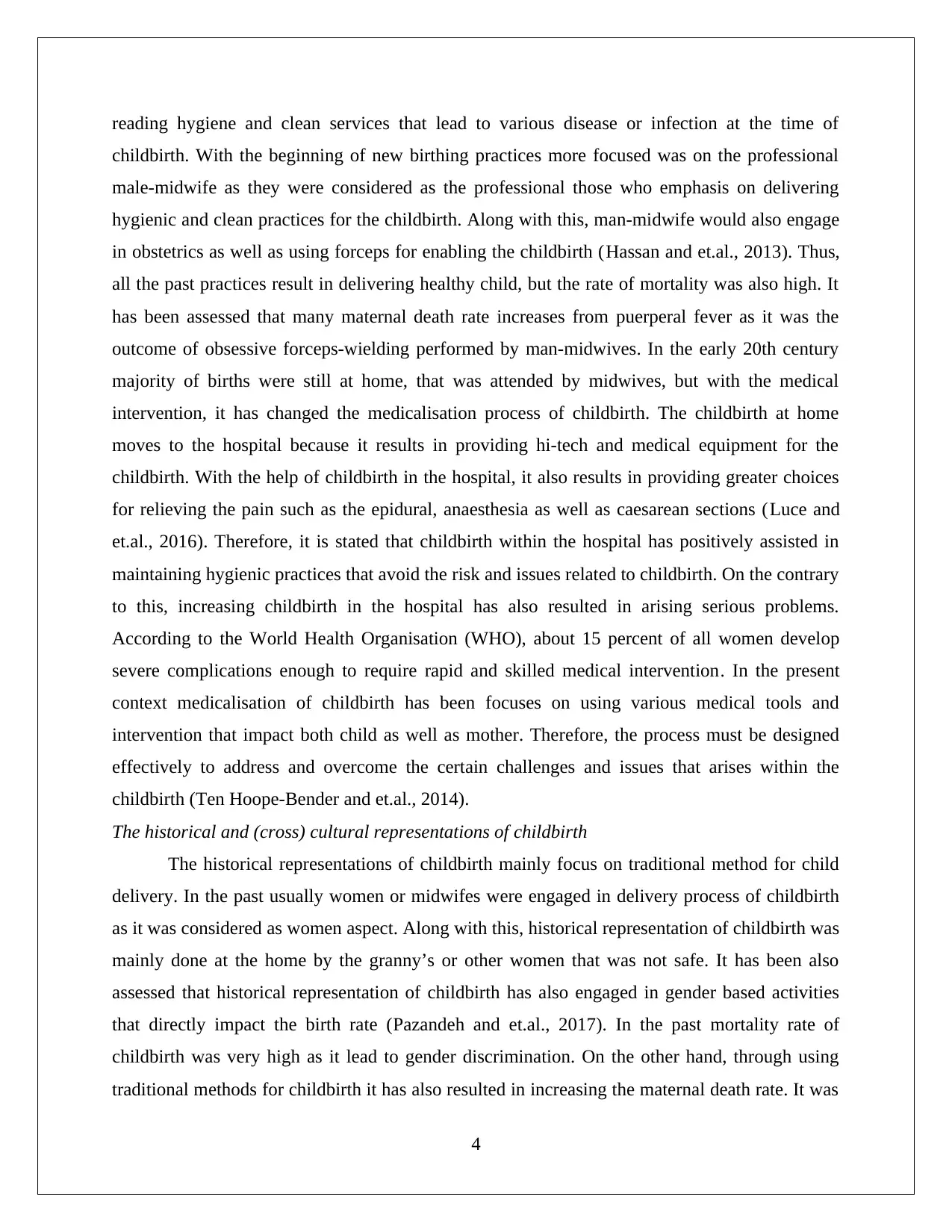
reading hygiene and clean services that lead to various disease or infection at the time of
childbirth. With the beginning of new birthing practices more focused was on the professional
male-midwife as they were considered as the professional those who emphasis on delivering
hygienic and clean practices for the childbirth. Along with this, man-midwife would also engage
in obstetrics as well as using forceps for enabling the childbirth (Hassan and et.al., 2013). Thus,
all the past practices result in delivering healthy child, but the rate of mortality was also high. It
has been assessed that many maternal death rate increases from puerperal fever as it was the
outcome of obsessive forceps-wielding performed by man-midwives. In the early 20th century
majority of births were still at home, that was attended by midwives, but with the medical
intervention, it has changed the medicalisation process of childbirth. The childbirth at home
moves to the hospital because it results in providing hi-tech and medical equipment for the
childbirth. With the help of childbirth in the hospital, it also results in providing greater choices
for relieving the pain such as the epidural, anaesthesia as well as caesarean sections (Luce and
et.al., 2016). Therefore, it is stated that childbirth within the hospital has positively assisted in
maintaining hygienic practices that avoid the risk and issues related to childbirth. On the contrary
to this, increasing childbirth in the hospital has also resulted in arising serious problems.
According to the World Health Organisation (WHO), about 15 percent of all women develop
severe complications enough to require rapid and skilled medical intervention. In the present
context medicalisation of childbirth has been focuses on using various medical tools and
intervention that impact both child as well as mother. Therefore, the process must be designed
effectively to address and overcome the certain challenges and issues that arises within the
childbirth (Ten Hoope-Bender and et.al., 2014).
The historical and (cross) cultural representations of childbirth
The historical representations of childbirth mainly focus on traditional method for child
delivery. In the past usually women or midwifes were engaged in delivery process of childbirth
as it was considered as women aspect. Along with this, historical representation of childbirth was
mainly done at the home by the granny’s or other women that was not safe. It has been also
assessed that historical representation of childbirth has also engaged in gender based activities
that directly impact the birth rate (Pazandeh and et.al., 2017). In the past mortality rate of
childbirth was very high as it lead to gender discrimination. On the other hand, through using
traditional methods for childbirth it has also resulted in increasing the maternal death rate. It was
4
childbirth. With the beginning of new birthing practices more focused was on the professional
male-midwife as they were considered as the professional those who emphasis on delivering
hygienic and clean practices for the childbirth. Along with this, man-midwife would also engage
in obstetrics as well as using forceps for enabling the childbirth (Hassan and et.al., 2013). Thus,
all the past practices result in delivering healthy child, but the rate of mortality was also high. It
has been assessed that many maternal death rate increases from puerperal fever as it was the
outcome of obsessive forceps-wielding performed by man-midwives. In the early 20th century
majority of births were still at home, that was attended by midwives, but with the medical
intervention, it has changed the medicalisation process of childbirth. The childbirth at home
moves to the hospital because it results in providing hi-tech and medical equipment for the
childbirth. With the help of childbirth in the hospital, it also results in providing greater choices
for relieving the pain such as the epidural, anaesthesia as well as caesarean sections (Luce and
et.al., 2016). Therefore, it is stated that childbirth within the hospital has positively assisted in
maintaining hygienic practices that avoid the risk and issues related to childbirth. On the contrary
to this, increasing childbirth in the hospital has also resulted in arising serious problems.
According to the World Health Organisation (WHO), about 15 percent of all women develop
severe complications enough to require rapid and skilled medical intervention. In the present
context medicalisation of childbirth has been focuses on using various medical tools and
intervention that impact both child as well as mother. Therefore, the process must be designed
effectively to address and overcome the certain challenges and issues that arises within the
childbirth (Ten Hoope-Bender and et.al., 2014).
The historical and (cross) cultural representations of childbirth
The historical representations of childbirth mainly focus on traditional method for child
delivery. In the past usually women or midwifes were engaged in delivery process of childbirth
as it was considered as women aspect. Along with this, historical representation of childbirth was
mainly done at the home by the granny’s or other women that was not safe. It has been also
assessed that historical representation of childbirth has also engaged in gender based activities
that directly impact the birth rate (Pazandeh and et.al., 2017). In the past mortality rate of
childbirth was very high as it lead to gender discrimination. On the other hand, through using
traditional methods for childbirth it has also resulted in increasing the maternal death rate. It was
4
Paraphrase This Document
Need a fresh take? Get an instant paraphrase of this document with our AI Paraphraser
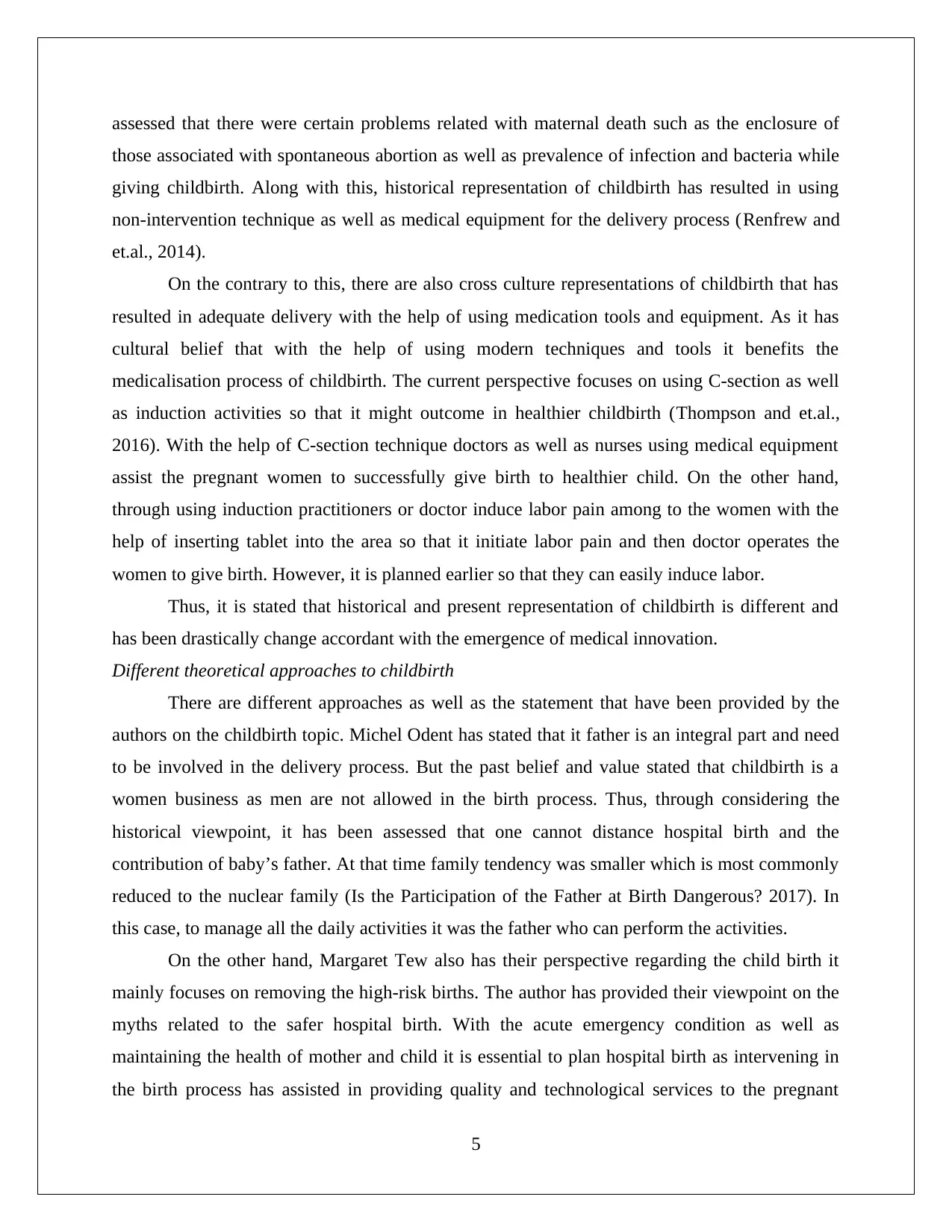
assessed that there were certain problems related with maternal death such as the enclosure of
those associated with spontaneous abortion as well as prevalence of infection and bacteria while
giving childbirth. Along with this, historical representation of childbirth has resulted in using
non-intervention technique as well as medical equipment for the delivery process (Renfrew and
et.al., 2014).
On the contrary to this, there are also cross culture representations of childbirth that has
resulted in adequate delivery with the help of using medication tools and equipment. As it has
cultural belief that with the help of using modern techniques and tools it benefits the
medicalisation process of childbirth. The current perspective focuses on using C-section as well
as induction activities so that it might outcome in healthier childbirth (Thompson and et.al.,
2016). With the help of C-section technique doctors as well as nurses using medical equipment
assist the pregnant women to successfully give birth to healthier child. On the other hand,
through using induction practitioners or doctor induce labor pain among to the women with the
help of inserting tablet into the area so that it initiate labor pain and then doctor operates the
women to give birth. However, it is planned earlier so that they can easily induce labor.
Thus, it is stated that historical and present representation of childbirth is different and
has been drastically change accordant with the emergence of medical innovation.
Different theoretical approaches to childbirth
There are different approaches as well as the statement that have been provided by the
authors on the childbirth topic. Michel Odent has stated that it father is an integral part and need
to be involved in the delivery process. But the past belief and value stated that childbirth is a
women business as men are not allowed in the birth process. Thus, through considering the
historical viewpoint, it has been assessed that one cannot distance hospital birth and the
contribution of baby’s father. At that time family tendency was smaller which is most commonly
reduced to the nuclear family (Is the Participation of the Father at Birth Dangerous? 2017). In
this case, to manage all the daily activities it was the father who can perform the activities.
On the other hand, Margaret Tew also has their perspective regarding the child birth it
mainly focuses on removing the high-risk births. The author has provided their viewpoint on the
myths related to the safer hospital birth. With the acute emergency condition as well as
maintaining the health of mother and child it is essential to plan hospital birth as intervening in
the birth process has assisted in providing quality and technological services to the pregnant
5
those associated with spontaneous abortion as well as prevalence of infection and bacteria while
giving childbirth. Along with this, historical representation of childbirth has resulted in using
non-intervention technique as well as medical equipment for the delivery process (Renfrew and
et.al., 2014).
On the contrary to this, there are also cross culture representations of childbirth that has
resulted in adequate delivery with the help of using medication tools and equipment. As it has
cultural belief that with the help of using modern techniques and tools it benefits the
medicalisation process of childbirth. The current perspective focuses on using C-section as well
as induction activities so that it might outcome in healthier childbirth (Thompson and et.al.,
2016). With the help of C-section technique doctors as well as nurses using medical equipment
assist the pregnant women to successfully give birth to healthier child. On the other hand,
through using induction practitioners or doctor induce labor pain among to the women with the
help of inserting tablet into the area so that it initiate labor pain and then doctor operates the
women to give birth. However, it is planned earlier so that they can easily induce labor.
Thus, it is stated that historical and present representation of childbirth is different and
has been drastically change accordant with the emergence of medical innovation.
Different theoretical approaches to childbirth
There are different approaches as well as the statement that have been provided by the
authors on the childbirth topic. Michel Odent has stated that it father is an integral part and need
to be involved in the delivery process. But the past belief and value stated that childbirth is a
women business as men are not allowed in the birth process. Thus, through considering the
historical viewpoint, it has been assessed that one cannot distance hospital birth and the
contribution of baby’s father. At that time family tendency was smaller which is most commonly
reduced to the nuclear family (Is the Participation of the Father at Birth Dangerous? 2017). In
this case, to manage all the daily activities it was the father who can perform the activities.
On the other hand, Margaret Tew also has their perspective regarding the child birth it
mainly focuses on removing the high-risk births. The author has provided their viewpoint on the
myths related to the safer hospital birth. With the acute emergency condition as well as
maintaining the health of mother and child it is essential to plan hospital birth as intervening in
the birth process has assisted in providing quality and technological services to the pregnant
5
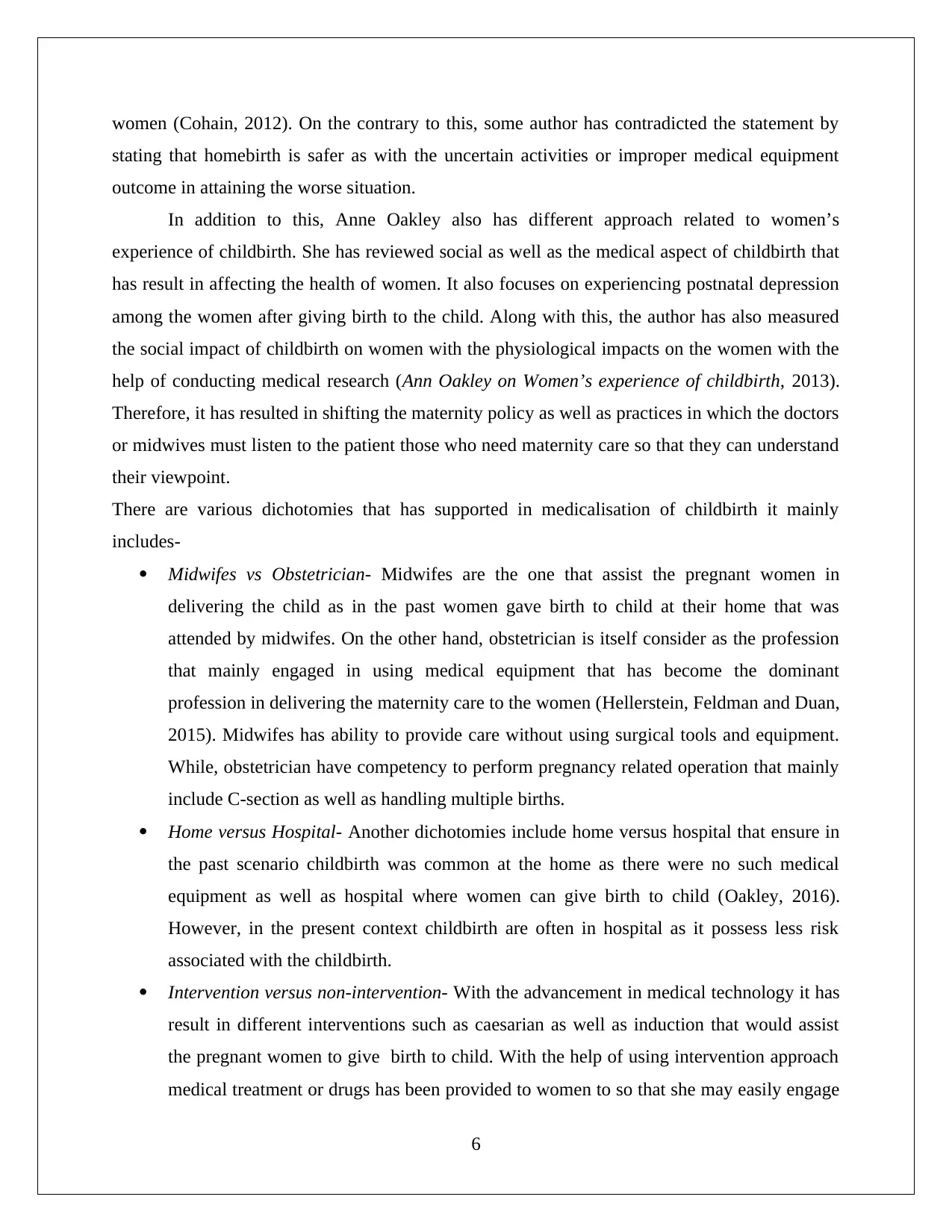
women (Cohain, 2012). On the contrary to this, some author has contradicted the statement by
stating that homebirth is safer as with the uncertain activities or improper medical equipment
outcome in attaining the worse situation.
In addition to this, Anne Oakley also has different approach related to women’s
experience of childbirth. She has reviewed social as well as the medical aspect of childbirth that
has result in affecting the health of women. It also focuses on experiencing postnatal depression
among the women after giving birth to the child. Along with this, the author has also measured
the social impact of childbirth on women with the physiological impacts on the women with the
help of conducting medical research (Ann Oakley on Women’s experience of childbirth, 2013).
Therefore, it has resulted in shifting the maternity policy as well as practices in which the doctors
or midwives must listen to the patient those who need maternity care so that they can understand
their viewpoint.
There are various dichotomies that has supported in medicalisation of childbirth it mainly
includes-
Midwifes vs Obstetrician- Midwifes are the one that assist the pregnant women in
delivering the child as in the past women gave birth to child at their home that was
attended by midwifes. On the other hand, obstetrician is itself consider as the profession
that mainly engaged in using medical equipment that has become the dominant
profession in delivering the maternity care to the women (Hellerstein, Feldman and Duan,
2015). Midwifes has ability to provide care without using surgical tools and equipment.
While, obstetrician have competency to perform pregnancy related operation that mainly
include C-section as well as handling multiple births.
Home versus Hospital- Another dichotomies include home versus hospital that ensure in
the past scenario childbirth was common at the home as there were no such medical
equipment as well as hospital where women can give birth to child (Oakley, 2016).
However, in the present context childbirth are often in hospital as it possess less risk
associated with the childbirth.
Intervention versus non-intervention- With the advancement in medical technology it has
result in different interventions such as caesarian as well as induction that would assist
the pregnant women to give birth to child. With the help of using intervention approach
medical treatment or drugs has been provided to women to so that she may easily engage
6
stating that homebirth is safer as with the uncertain activities or improper medical equipment
outcome in attaining the worse situation.
In addition to this, Anne Oakley also has different approach related to women’s
experience of childbirth. She has reviewed social as well as the medical aspect of childbirth that
has result in affecting the health of women. It also focuses on experiencing postnatal depression
among the women after giving birth to the child. Along with this, the author has also measured
the social impact of childbirth on women with the physiological impacts on the women with the
help of conducting medical research (Ann Oakley on Women’s experience of childbirth, 2013).
Therefore, it has resulted in shifting the maternity policy as well as practices in which the doctors
or midwives must listen to the patient those who need maternity care so that they can understand
their viewpoint.
There are various dichotomies that has supported in medicalisation of childbirth it mainly
includes-
Midwifes vs Obstetrician- Midwifes are the one that assist the pregnant women in
delivering the child as in the past women gave birth to child at their home that was
attended by midwifes. On the other hand, obstetrician is itself consider as the profession
that mainly engaged in using medical equipment that has become the dominant
profession in delivering the maternity care to the women (Hellerstein, Feldman and Duan,
2015). Midwifes has ability to provide care without using surgical tools and equipment.
While, obstetrician have competency to perform pregnancy related operation that mainly
include C-section as well as handling multiple births.
Home versus Hospital- Another dichotomies include home versus hospital that ensure in
the past scenario childbirth was common at the home as there were no such medical
equipment as well as hospital where women can give birth to child (Oakley, 2016).
However, in the present context childbirth are often in hospital as it possess less risk
associated with the childbirth.
Intervention versus non-intervention- With the advancement in medical technology it has
result in different interventions such as caesarian as well as induction that would assist
the pregnant women to give birth to child. With the help of using intervention approach
medical treatment or drugs has been provided to women to so that she may easily engage
6
⊘ This is a preview!⊘
Do you want full access?
Subscribe today to unlock all pages.

Trusted by 1+ million students worldwide
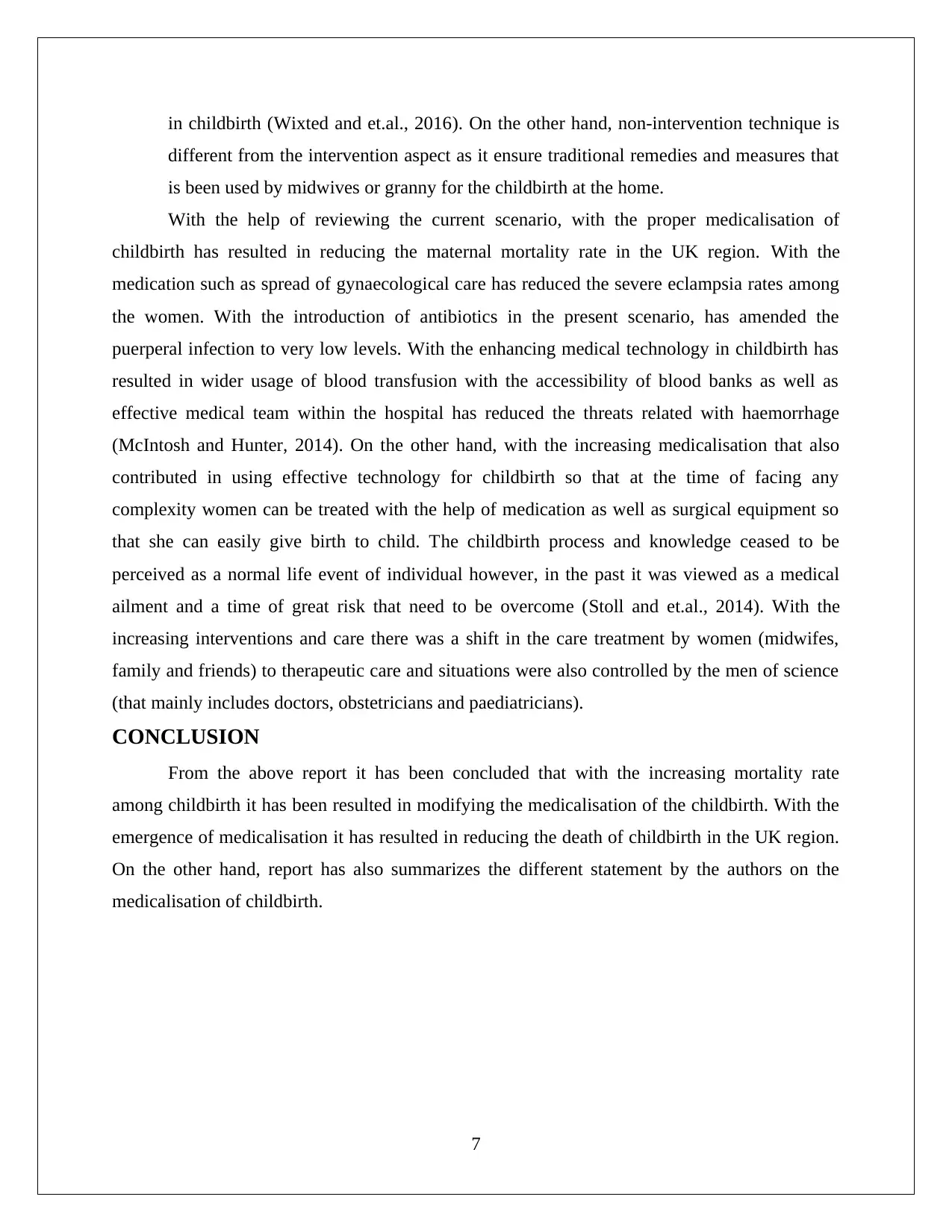
in childbirth (Wixted and et.al., 2016). On the other hand, non-intervention technique is
different from the intervention aspect as it ensure traditional remedies and measures that
is been used by midwives or granny for the childbirth at the home.
With the help of reviewing the current scenario, with the proper medicalisation of
childbirth has resulted in reducing the maternal mortality rate in the UK region. With the
medication such as spread of gynaecological care has reduced the severe eclampsia rates among
the women. With the introduction of antibiotics in the present scenario, has amended the
puerperal infection to very low levels. With the enhancing medical technology in childbirth has
resulted in wider usage of blood transfusion with the accessibility of blood banks as well as
effective medical team within the hospital has reduced the threats related with haemorrhage
(McIntosh and Hunter, 2014). On the other hand, with the increasing medicalisation that also
contributed in using effective technology for childbirth so that at the time of facing any
complexity women can be treated with the help of medication as well as surgical equipment so
that she can easily give birth to child. The childbirth process and knowledge ceased to be
perceived as a normal life event of individual however, in the past it was viewed as a medical
ailment and a time of great risk that need to be overcome (Stoll and et.al., 2014). With the
increasing interventions and care there was a shift in the care treatment by women (midwifes,
family and friends) to therapeutic care and situations were also controlled by the men of science
(that mainly includes doctors, obstetricians and paediatricians).
CONCLUSION
From the above report it has been concluded that with the increasing mortality rate
among childbirth it has been resulted in modifying the medicalisation of the childbirth. With the
emergence of medicalisation it has resulted in reducing the death of childbirth in the UK region.
On the other hand, report has also summarizes the different statement by the authors on the
medicalisation of childbirth.
7
different from the intervention aspect as it ensure traditional remedies and measures that
is been used by midwives or granny for the childbirth at the home.
With the help of reviewing the current scenario, with the proper medicalisation of
childbirth has resulted in reducing the maternal mortality rate in the UK region. With the
medication such as spread of gynaecological care has reduced the severe eclampsia rates among
the women. With the introduction of antibiotics in the present scenario, has amended the
puerperal infection to very low levels. With the enhancing medical technology in childbirth has
resulted in wider usage of blood transfusion with the accessibility of blood banks as well as
effective medical team within the hospital has reduced the threats related with haemorrhage
(McIntosh and Hunter, 2014). On the other hand, with the increasing medicalisation that also
contributed in using effective technology for childbirth so that at the time of facing any
complexity women can be treated with the help of medication as well as surgical equipment so
that she can easily give birth to child. The childbirth process and knowledge ceased to be
perceived as a normal life event of individual however, in the past it was viewed as a medical
ailment and a time of great risk that need to be overcome (Stoll and et.al., 2014). With the
increasing interventions and care there was a shift in the care treatment by women (midwifes,
family and friends) to therapeutic care and situations were also controlled by the men of science
(that mainly includes doctors, obstetricians and paediatricians).
CONCLUSION
From the above report it has been concluded that with the increasing mortality rate
among childbirth it has been resulted in modifying the medicalisation of the childbirth. With the
emergence of medicalisation it has resulted in reducing the death of childbirth in the UK region.
On the other hand, report has also summarizes the different statement by the authors on the
medicalisation of childbirth.
7
Paraphrase This Document
Need a fresh take? Get an instant paraphrase of this document with our AI Paraphraser
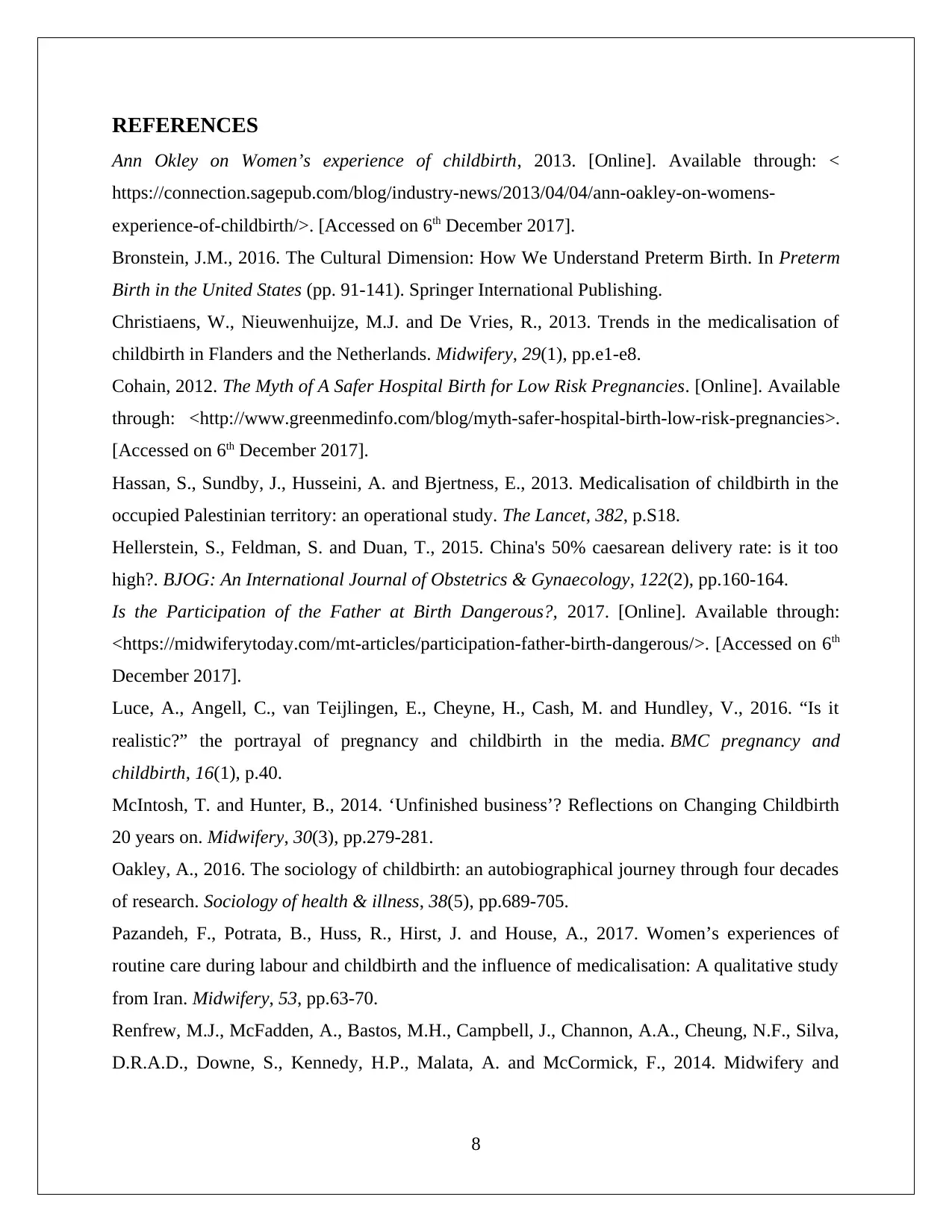
REFERENCES
Ann Okley on Women’s experience of childbirth, 2013. [Online]. Available through: <
https://connection.sagepub.com/blog/industry-news/2013/04/04/ann-oakley-on-womens-
experience-of-childbirth/>. [Accessed on 6th December 2017].
Bronstein, J.M., 2016. The Cultural Dimension: How We Understand Preterm Birth. In Preterm
Birth in the United States (pp. 91-141). Springer International Publishing.
Christiaens, W., Nieuwenhuijze, M.J. and De Vries, R., 2013. Trends in the medicalisation of
childbirth in Flanders and the Netherlands. Midwifery, 29(1), pp.e1-e8.
Cohain, 2012. The Myth of A Safer Hospital Birth for Low Risk Pregnancies. [Online]. Available
through: <http://www.greenmedinfo.com/blog/myth-safer-hospital-birth-low-risk-pregnancies>.
[Accessed on 6th December 2017].
Hassan, S., Sundby, J., Husseini, A. and Bjertness, E., 2013. Medicalisation of childbirth in the
occupied Palestinian territory: an operational study. The Lancet, 382, p.S18.
Hellerstein, S., Feldman, S. and Duan, T., 2015. China's 50% caesarean delivery rate: is it too
high?. BJOG: An International Journal of Obstetrics & Gynaecology, 122(2), pp.160-164.
Is the Participation of the Father at Birth Dangerous?, 2017. [Online]. Available through:
<https://midwiferytoday.com/mt-articles/participation-father-birth-dangerous/>. [Accessed on 6th
December 2017].
Luce, A., Angell, C., van Teijlingen, E., Cheyne, H., Cash, M. and Hundley, V., 2016. “Is it
realistic?” the portrayal of pregnancy and childbirth in the media. BMC pregnancy and
childbirth, 16(1), p.40.
McIntosh, T. and Hunter, B., 2014. ‘Unfinished business’? Reflections on Changing Childbirth
20 years on. Midwifery, 30(3), pp.279-281.
Oakley, A., 2016. The sociology of childbirth: an autobiographical journey through four decades
of research. Sociology of health & illness, 38(5), pp.689-705.
Pazandeh, F., Potrata, B., Huss, R., Hirst, J. and House, A., 2017. Women’s experiences of
routine care during labour and childbirth and the influence of medicalisation: A qualitative study
from Iran. Midwifery, 53, pp.63-70.
Renfrew, M.J., McFadden, A., Bastos, M.H., Campbell, J., Channon, A.A., Cheung, N.F., Silva,
D.R.A.D., Downe, S., Kennedy, H.P., Malata, A. and McCormick, F., 2014. Midwifery and
8
Ann Okley on Women’s experience of childbirth, 2013. [Online]. Available through: <
https://connection.sagepub.com/blog/industry-news/2013/04/04/ann-oakley-on-womens-
experience-of-childbirth/>. [Accessed on 6th December 2017].
Bronstein, J.M., 2016. The Cultural Dimension: How We Understand Preterm Birth. In Preterm
Birth in the United States (pp. 91-141). Springer International Publishing.
Christiaens, W., Nieuwenhuijze, M.J. and De Vries, R., 2013. Trends in the medicalisation of
childbirth in Flanders and the Netherlands. Midwifery, 29(1), pp.e1-e8.
Cohain, 2012. The Myth of A Safer Hospital Birth for Low Risk Pregnancies. [Online]. Available
through: <http://www.greenmedinfo.com/blog/myth-safer-hospital-birth-low-risk-pregnancies>.
[Accessed on 6th December 2017].
Hassan, S., Sundby, J., Husseini, A. and Bjertness, E., 2013. Medicalisation of childbirth in the
occupied Palestinian territory: an operational study. The Lancet, 382, p.S18.
Hellerstein, S., Feldman, S. and Duan, T., 2015. China's 50% caesarean delivery rate: is it too
high?. BJOG: An International Journal of Obstetrics & Gynaecology, 122(2), pp.160-164.
Is the Participation of the Father at Birth Dangerous?, 2017. [Online]. Available through:
<https://midwiferytoday.com/mt-articles/participation-father-birth-dangerous/>. [Accessed on 6th
December 2017].
Luce, A., Angell, C., van Teijlingen, E., Cheyne, H., Cash, M. and Hundley, V., 2016. “Is it
realistic?” the portrayal of pregnancy and childbirth in the media. BMC pregnancy and
childbirth, 16(1), p.40.
McIntosh, T. and Hunter, B., 2014. ‘Unfinished business’? Reflections on Changing Childbirth
20 years on. Midwifery, 30(3), pp.279-281.
Oakley, A., 2016. The sociology of childbirth: an autobiographical journey through four decades
of research. Sociology of health & illness, 38(5), pp.689-705.
Pazandeh, F., Potrata, B., Huss, R., Hirst, J. and House, A., 2017. Women’s experiences of
routine care during labour and childbirth and the influence of medicalisation: A qualitative study
from Iran. Midwifery, 53, pp.63-70.
Renfrew, M.J., McFadden, A., Bastos, M.H., Campbell, J., Channon, A.A., Cheung, N.F., Silva,
D.R.A.D., Downe, S., Kennedy, H.P., Malata, A. and McCormick, F., 2014. Midwifery and
8
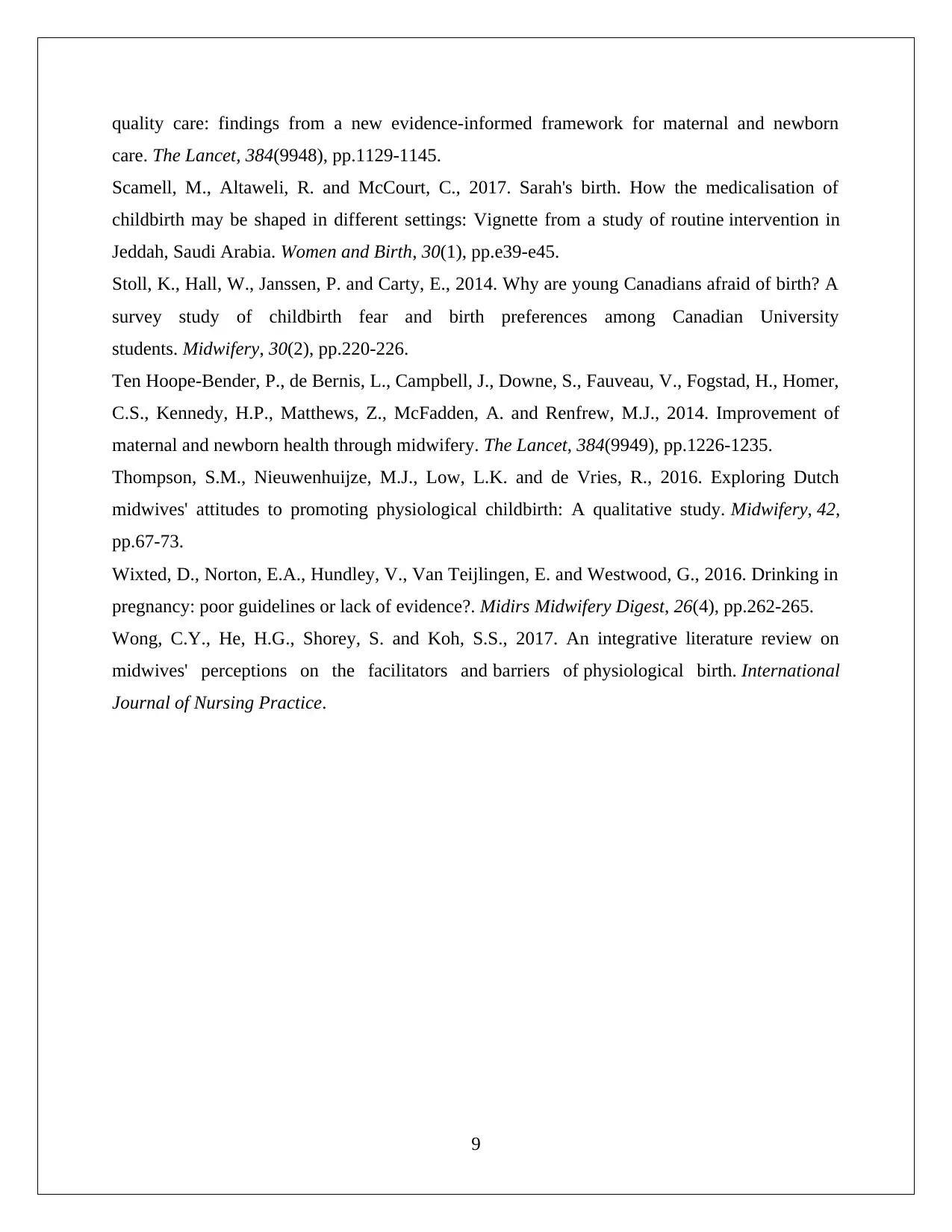
quality care: findings from a new evidence-informed framework for maternal and newborn
care. The Lancet, 384(9948), pp.1129-1145.
Scamell, M., Altaweli, R. and McCourt, C., 2017. Sarah's birth. How the medicalisation of
childbirth may be shaped in different settings: Vignette from a study of routine intervention in
Jeddah, Saudi Arabia. Women and Birth, 30(1), pp.e39-e45.
Stoll, K., Hall, W., Janssen, P. and Carty, E., 2014. Why are young Canadians afraid of birth? A
survey study of childbirth fear and birth preferences among Canadian University
students. Midwifery, 30(2), pp.220-226.
Ten Hoope-Bender, P., de Bernis, L., Campbell, J., Downe, S., Fauveau, V., Fogstad, H., Homer,
C.S., Kennedy, H.P., Matthews, Z., McFadden, A. and Renfrew, M.J., 2014. Improvement of
maternal and newborn health through midwifery. The Lancet, 384(9949), pp.1226-1235.
Thompson, S.M., Nieuwenhuijze, M.J., Low, L.K. and de Vries, R., 2016. Exploring Dutch
midwives' attitudes to promoting physiological childbirth: A qualitative study. Midwifery, 42,
pp.67-73.
Wixted, D., Norton, E.A., Hundley, V., Van Teijlingen, E. and Westwood, G., 2016. Drinking in
pregnancy: poor guidelines or lack of evidence?. Midirs Midwifery Digest, 26(4), pp.262-265.
Wong, C.Y., He, H.G., Shorey, S. and Koh, S.S., 2017. An integrative literature review on
midwives' perceptions on the facilitators and barriers of physiological birth. International
Journal of Nursing Practice.
9
care. The Lancet, 384(9948), pp.1129-1145.
Scamell, M., Altaweli, R. and McCourt, C., 2017. Sarah's birth. How the medicalisation of
childbirth may be shaped in different settings: Vignette from a study of routine intervention in
Jeddah, Saudi Arabia. Women and Birth, 30(1), pp.e39-e45.
Stoll, K., Hall, W., Janssen, P. and Carty, E., 2014. Why are young Canadians afraid of birth? A
survey study of childbirth fear and birth preferences among Canadian University
students. Midwifery, 30(2), pp.220-226.
Ten Hoope-Bender, P., de Bernis, L., Campbell, J., Downe, S., Fauveau, V., Fogstad, H., Homer,
C.S., Kennedy, H.P., Matthews, Z., McFadden, A. and Renfrew, M.J., 2014. Improvement of
maternal and newborn health through midwifery. The Lancet, 384(9949), pp.1226-1235.
Thompson, S.M., Nieuwenhuijze, M.J., Low, L.K. and de Vries, R., 2016. Exploring Dutch
midwives' attitudes to promoting physiological childbirth: A qualitative study. Midwifery, 42,
pp.67-73.
Wixted, D., Norton, E.A., Hundley, V., Van Teijlingen, E. and Westwood, G., 2016. Drinking in
pregnancy: poor guidelines or lack of evidence?. Midirs Midwifery Digest, 26(4), pp.262-265.
Wong, C.Y., He, H.G., Shorey, S. and Koh, S.S., 2017. An integrative literature review on
midwives' perceptions on the facilitators and barriers of physiological birth. International
Journal of Nursing Practice.
9
⊘ This is a preview!⊘
Do you want full access?
Subscribe today to unlock all pages.

Trusted by 1+ million students worldwide
1 out of 9
Your All-in-One AI-Powered Toolkit for Academic Success.
+13062052269
info@desklib.com
Available 24*7 on WhatsApp / Email
![[object Object]](/_next/static/media/star-bottom.7253800d.svg)
Unlock your academic potential
Copyright © 2020–2025 A2Z Services. All Rights Reserved. Developed and managed by ZUCOL.
